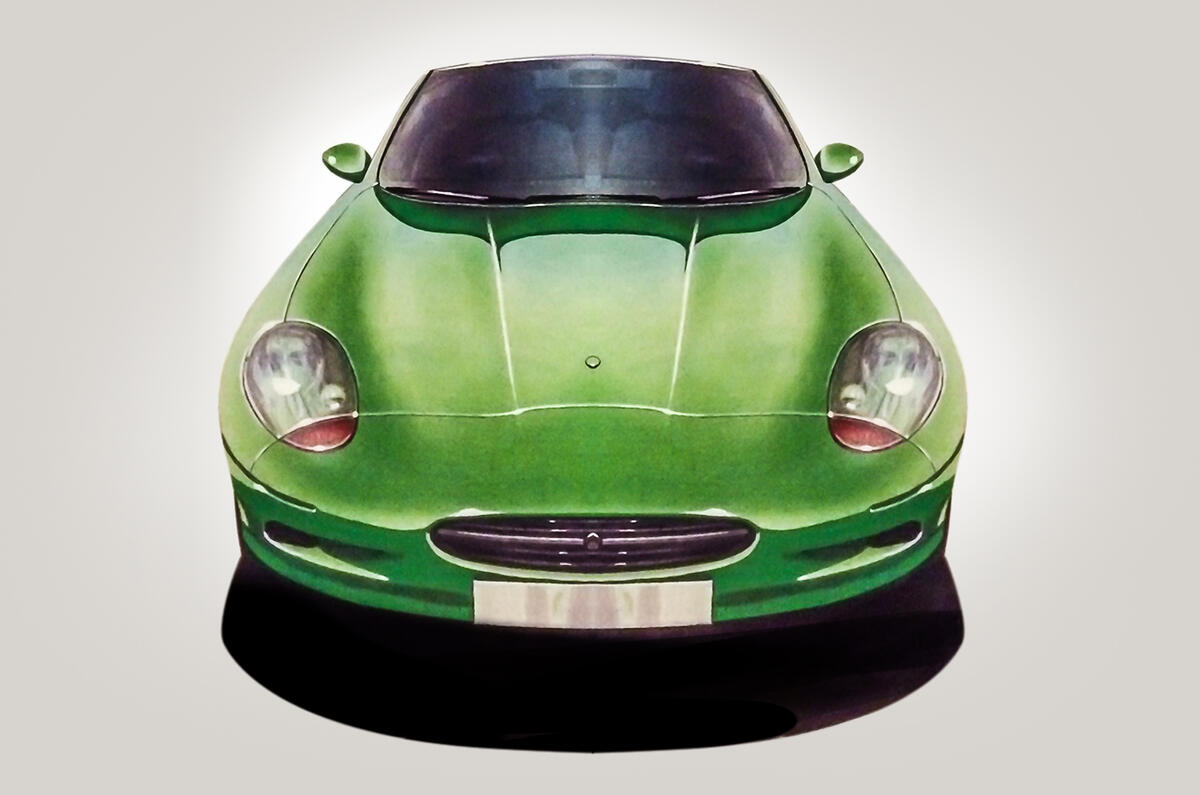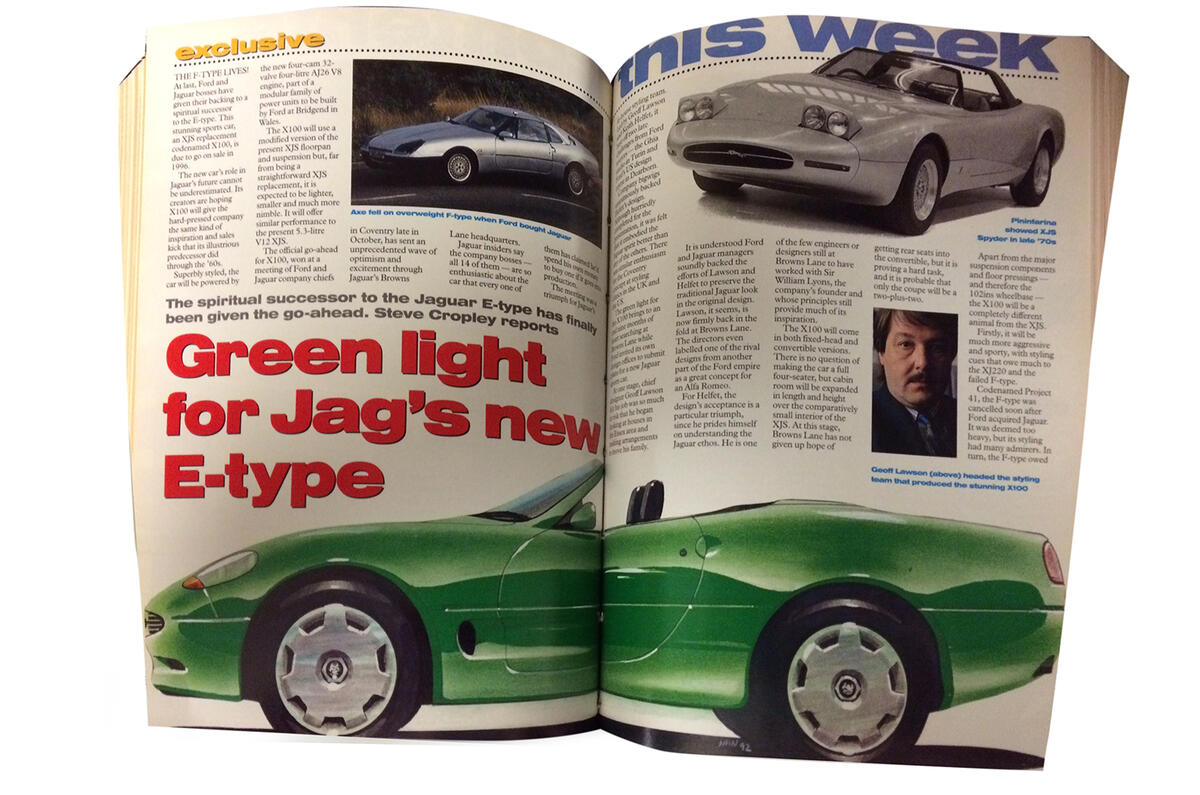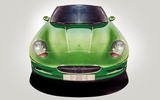The 37 years between the demise of the E-Type in 1975 and the launch of the F-Type in 2012 were packed with ‘what if’ and ‘nearly’ moments as Jaguar explored how to replace the most famous and beautiful car of all time.
The XJS may have immediately followed the E-Type out of Browns Lane, remaining in production until 1996, but, fine as it was, it would never be seen as a true successor. Nor was it trying to be.
The ‘F-Type’ nearly arrived in the mid-1980s, with the XJ-41 convertible and XJ-42 coupé designed to replace the XJS with a model much more akin to the E-Type, until new owner Ford arrived and killed a project that, in truth, had spent too long in development by that point and had gotten too heavy anyway.
Read our history of the iconic Jaguar E-Type
Then came the X100 in 1996, a car we know now as the XK, but in Autocar’s scoop story of 11 November 1992, all signs pointed to the fact that the E-Type’s true successor, the Jaguar F-Type, was coming.
An intrepid news reporter by the name of Steve Cropley got the scoop. “At last, Ford and Jaguar bosses have given their backing to a spiritual successor to the E-Type,” Cropley reported. “This stunning sports car, an XJS replacement codenamed X100, is due on sale in 1996.”
Cropley continued: “The X100 will use a modified version of the present XJS floorpan and suspension, but far from being a straightforward XJS replacement, it is expected to be lighter, smaller and much more nimble.”
The X100 was to be “superbly styled” and be powered by a new four-cam, 32-valve, 4.0-litre AJ26 V8 from a modular family of engines to come from Ford’s Bridgend factory. Performance was tipped to match the 5.3-litre V12-powered XJS of the day, with a 140mph top speed and a 0-60mph time of less than seven seconds.
As for the handling, Cropley reported that “the efforts of some of the UK’s finest suspension engineers will make the X100 the sports car the XJS never was. This will be a car to be driven”.
Cropley’s sources had told him that the car was signed off in October 1992 at a meeting in Coventry between Ford and Jaguar bosses, a decision that “sent an unprecedented wave of optimism and excitement through Jaguar’s Browns Lane headquarters”. Indeed, so enthused were Jaguar’s 14 bosses with the car that “every one of them has claimed he’d spend his own money to buy one”.
On those looks, the X100 was the work of Jaguar’s in-house design team, headed by Geoff Lawson and Keith Helfet. The design saw off challenges from Ford HQ’s design studio in Dearborn and the Ghia studio in Turin, something Cropley noted as significant, with Lawson and Helfet being able to “preserve the traditional Jaguar look”.
Before the X100 could be launched four years after Cropley’s scoop, Jaguar had to overcome sagging sales in its key US and UK markets and also get the X300 into production as a replacement for the XJ6. The XJS also had to be kept fresh in the intervening years.
“Lingering problems or not,” Cropley started his sign-off, “this is a great moment in Jaguar’s history. Concrete plans are now afoot for the beleaguered company to produce its most keenly awaited car, its most radical design in 30 years and a probable lifesaver.”
The X100 did go on sale in 1996, but by then it was called the XK. Still more GT than sports car, the XK stayed in production until last year, by which time the E-Type had been replaced in Jaguar’s line-up once and for all with a proper sports car. Called F-Type, of course.
Previous Throwback Thursdays
4 March 1899 - Steam, electric or combustion engine?
26 June 1906 - The first French Grand Prix
9 July 1907 - The beginning of Brooklands
14 February 1913 - 100 miles in one hour
8 April 1916 - Making post-war predictions
25 March 1922 - Caterpillar tracks are the future
4 July 1925 - Citroën lights up the Eiffel Tower
28 September 1928 - Engine tech takes a great leap forwards
2 February 1934 - The ethics of skidding
6 July 1934 - A tour of Cowley
1 June 1935 - Introduction of the driving test
22 June 1945 - Driving through post-WW2 Europe
21 January 1949 - Tidier tails
25 August 1950 - The evolution of transmissions
27 April 1951 - Frankfurt hosts its first motor show
24 April 1959 - Aston Martin enters Formula 1
16 September 1960 - The beginning of MOT tests
28 October 1960 - Economy driving 1960s style
27 January 1961 - Ford Thunderbird road test
17 November 1961 - TVR Grantura road test
10 September 1965 - The birth of modern Audi
19 August 1966 - Four-wheel drive on test
6 May 1971 - Driving Ford's Supervan
12 June 1976 - Cars for under £100
10 July 1976 - Land's End to John O'Groats on one tank
8 October 1977 - Music on the move
13 May 1978 - Ferrari 512 BB road test
19 January 1980 - Talbot Horizon road test
13 February 1982 - 4x4s tested on the farm
17 April 1985 - Secrets of a lost British supercar
4 September 1985 - Ford's electronic test bed
15 August 1990 - Giugiaro's vision of a 1990s Jaguar
28 April 1993 - BL's unseen concepts
16 March 1994 - Bentley's Concept Java
16 April 1997 - When Bugatti bit the dust
11 October 2000 - BMW X5 Le Mans
4 April 2001 - 0-260mph in 6.0 seconds











Join the debate
Add your comment
Is this the DB7?
XJS fine?